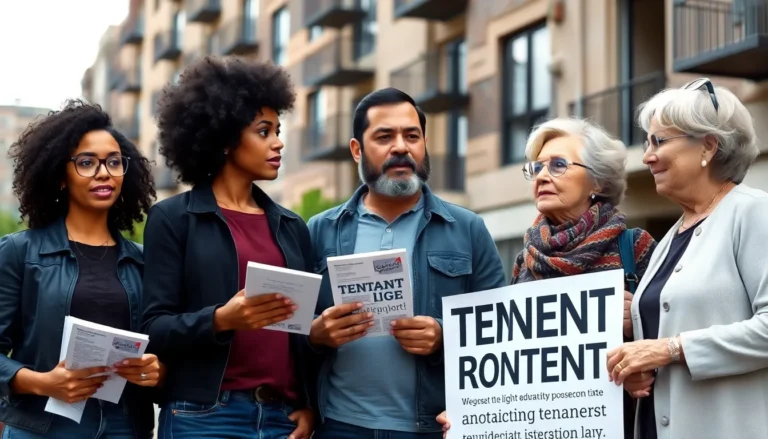Table of Contents
ToggleIn a world where rent prices seem to rise faster than a cat on a hot tin roof, rent stabilization enters the scene like a superhero in a slightly wrinkled cape. It promises to keep housing affordable and protect tenants from the whims of landlords who might otherwise charge an arm and a leg for a studio apartment that’s barely big enough for a goldfish.
Overview of Rent Stabilization
Rent stabilization plays a key role in ensuring housing affordability amid rising rent prices. This approach safeguards tenants against excessive rent increases, thus maintaining access to viable living options.
Definition and Purpose
Rent stabilization refers to laws that set limits on how much landlords can increase rent for residential units. Its primary purpose involves protecting tenants from sudden, steep rent hikes while promoting stability in rental markets. By capping annual rent increases, these laws create a balance between tenants’ rights and landlords’ interests. Furthermore, rent stabilization helps maintain diverse communities where individuals of various income levels can reside without fear of displacement.
Historical Context
The origins of rent stabilization trace back to the early-mid 20th century when economic hardships led to housing shortages. During this period, many cities implemented rent control measures to prevent landlords from exploiting vulnerable populations. In the aftermath of World War II, rental markets faced significant pressures, prompting governments to establish formal regulations on rent increases. Over the decades, various jurisdictions adopted rent stabilization policies, adapting them to local economic conditions and housing needs. This historical evolution reflects ongoing efforts to provide stability in affordable housing amidst changing economic landscapes.
Benefits of Rent Stabilization

Rent stabilization provides significant advantages for both tenants and communities. It fosters a fair rental market while ensuring housing affordability and security.
Protection for Tenants
Rent stabilization measures safeguard tenants from abrupt rent increases. By capping allowable annual rent hikes, these policies prevent landlords from imposing excessive charges that could lead to displacement. A consistent rent environment allows tenants to budget effectively and plan for the future. Stability in housing assists vulnerable populations, particularly those with fixed or low incomes. Protection mechanisms also enhance tenants’ rights, promoting a more equitable rental landscape that values their well-being.
Community Stability
Community stability thrives under rent stabilization policies. Residents of diverse income levels coexist, fostering a vibrant social fabric. When people can remain in their homes without fear of sudden rent hikes, neighborhoods become more cohesive. Stability encourages long-term commitments from tenants, which can lead to stronger community engagement. Economic diversity often becomes a hallmark of stable communities, contributing to local culture and fostering relationships between neighbors. Rent stabilization plays a pivotal role in maintaining this essential community aspect.
Challenges of Rent Stabilization
Rent stabilization presents several challenges that impact both landlords and the economy. Understanding these challenges is crucial for grasping the broader implications of these policies.
Impact on Landlords
Landlords face various difficulties under rent stabilization regulations. Capped rent increases limit their revenue potential, potentially leading to financial strain when costs rise. Property maintenance might suffer due to reduced funds, as financial constraints can restrict necessary upgrades. Many landlords report difficulty in covering property taxes, insurance, and maintenance with stable or decreasing rents. Consequently, some landlords may choose to withdraw from renting, reducing housing supply in tight markets.
Economic Implications
Rent stabilization may lead to unintended economic consequences. Distorted markets can emerge as landlords raise rents on vacant units to compensate for losses on stabilized properties. This practice creates a tiered rental market filled with disparities, which can further inflate housing costs. Additionally, reduced incentives for new construction can exacerbate housing shortages, affecting availability. The overall investment in affordable housing might decline, limiting options for low- and moderate-income households. As a result, local economies may struggle due to decreased housing stability and increased displacement rates.
Rent Stabilization Policies
Rent stabilization policies vary significantly across different regions in the United States. Certain areas implement strict rent controls, while others adopt more flexible approaches. New York City offers one of the most comprehensive rent stabilization systems, providing extensive protections for tenants and limiting rent increases. Conversely, cities like San Francisco have unique variations that blend rent control with other housing programs, reflecting local housing markets. Additionally, some states, such as California, incorporate statewide rent control measures, although specific regulations can differ by locality.
Variations by Region
Variations in rent stabilization laws illustrate diverse local housing needs. New York City stands out with its robust rent stabilization framework, protecting tenants in over a million apartments. Los Angeles presents a less comprehensive system, covering select buildings and limiting increases to a fixed percentage. Boston’s regulations focus on existing tenants, allowing landlords to increase rent significantly only upon vacancy. Chicago employs a mixed model, where some areas enforce rent control while others do not. Adapting to local conditions, these regulations aim to strike a balance between tenant protections and landlord interests.
Key Legislation
Key legislation defines the structure of rent stabilization across the U.S. The Rent Stabilization Law of 1969 in New York established foundational practices, controlling rent increases and preserving tenant rights. In California, the Tenant Protection Act of 2019 introduced statewide rent control, capping annual increases at 5% plus inflation. Illinois’ Rent Control Preemption Act limits cities from enacting rent control measures, shaping local housing policies. Other laws, such as the Costa-Hawkins Rental Housing Act, exempt certain properties from rent control regulations, impacting housing availability. Legislative frameworks evolve continually, responding to changing economic landscapes and housing demands.
Future of Rent Stabilization
Rent stabilization faces evolving challenges and opportunities in an ever-changing housing landscape. Emerging trends indicate a significant shift in how cities approach affordable housing policies.
Trends and Predictions
A review of current data shows increasing popularity for expanded rent stabilization measures across various urban areas. Some cities embrace policies that limit rent increases year-over-year to a fixed percentage, addressing affordability concerns. Additionally, more jurisdictions are implementing tenant protections directly linked to local economic conditions. Streams of data suggest greater public support for initiatives aimed at keeping housing affordable. Urban planners and policymakers anticipate these trends will continue as demand for affordable housing grows alongside rising living costs.
Potential Reforms
Efforts to reform existing rent stabilization laws could reshape the rental landscape significantly. Public discussions focus on adjusting rent control mechanisms to balance tenant protections and landlord revenues. Modifications may include incentivizing property maintenance or offering tax breaks to landlords meeting certain criteria. Some experts propose revisiting how exemptions and loopholes affect affordability and stability. States are likely to consider strategies that result in a stronger collaborative framework between tenants and landlords, aiming for sustainable housing solutions that adapt to evolving market pressures and community needs.
Rent stabilization plays a crucial role in ensuring that affordable housing remains accessible in an ever-changing economic landscape. By limiting rent increases, these laws not only protect tenants but also foster diverse communities that thrive on stability. As urban areas continue to grapple with housing demands, the evolution of rent stabilization policies will be vital in addressing both tenant needs and landlord concerns. The ongoing dialogue around these measures reflects a commitment to finding balanced solutions that promote sustainable living conditions for all. As cities adapt to new challenges, the future of rent stabilization will likely be shaped by collaborative efforts aimed at maintaining affordability while ensuring property upkeep.








